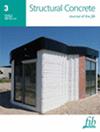采用不同等级混凝土和配筋率的 RC 柱的抗爆性能
IF 3.3
3区 工程技术
Q2 CONSTRUCTION & BUILDING TECHNOLOGY
引用次数: 0
摘要
本文旨在研究爆炸荷载下的 RC 柱行为。文中使用了 ABAQUS 软件中基于有限元模型的非线性动态三维(3D)有限元显式求解器。参数研究旨在提高 RC 柱在三种不同爆炸距离 z(即 0.23、0.5 和 1.07 m/kg1/3,用于近距离、中距离和远距离)下的抗爆性能。此外,还采用了三种等级的混凝土,即普通强度混凝土(NSC)、高强度混凝土(HSC)和超高性能混凝土(UHPC)。研究还考虑了三种配筋率,纵向和横向配筋率分别为(ρL = 1.28%、2.4% 和 3.1%)和(ρs = 0.6%、0.9% 和 1.35%)。此外,还考虑了三种不同的轴向载荷比(ALR = 0.01、0.2 和 0.4),以研究 ALR 增加对近距离爆炸下 RC 柱的影响。为了进一步研究,参数分析考虑了两种几何形状的 RC 柱(方形和圆形)。混凝土和钢筋的材料行为分别使用 ABAQUS 软件中的混凝土损伤塑性 (CDP) 模型和约翰逊-库克 (J-C) 模型来表示。根据实验研究对 FE 模型进行了初步验证。观察到的 FE 预测挠度和损伤与实际情况一致。此外,参数研究结果表明,随着配筋率的增加,RC 柱的爆炸挠度会明显减小。然而,提高混凝土标号可有效减少爆炸损坏和挠度。此外,与 NSC 相比,UHPC 能显著减少最大破坏和挠度,方柱和圆柱的最大破坏和挠度分别减少了约 60% 和 55%。本文章由计算机程序翻译,如有差异,请以英文原文为准。
Blast performance of RC columns with different levels of concrete grades and reinforcing ratios
The present article aims to study the behavior of RC columns under blast loading. A nonlinear dynamic Three‐Dimensional (3D) Finite Element FE model‐based explicit solver available in ABAQUS Software is used. A parametric study is investigated to enhance the blast resistance of RC columns under three different scaled distances z of an explosion, that is, 0.23, 0.5, and 1.07 m/kg1/3 for close, intermediate, and Far in‐distance. In addition, three levels of concrete grades are used, which are Normal Strength Concrete (NSC), High Strength Concrete (HSC), and Ultra High‐Performance Concrete (UHPC). The study also considers Three reinforcement ratios for longitudinal and transverse reinforcement ratios of (ρ L ρ s
求助全文
通过发布文献求助,成功后即可免费获取论文全文。
去求助
来源期刊

Structural Concrete
CONSTRUCTION & BUILDING TECHNOLOGY-ENGINEERING, CIVIL
CiteScore
5.60
自引率
15.60%
发文量
284
审稿时长
3 months
期刊介绍:
Structural Concrete, the official journal of the fib, provides conceptual and procedural guidance in the field of concrete construction, and features peer-reviewed papers, keynote research and industry news covering all aspects of the design, construction, performance in service and demolition of concrete structures.
Main topics:
design, construction, performance in service, conservation (assessment, maintenance, strengthening) and demolition of concrete structures
research about the behaviour of concrete structures
development of design methods
fib Model Code
sustainability of concrete structures.
 求助内容:
求助内容: 应助结果提醒方式:
应助结果提醒方式:


